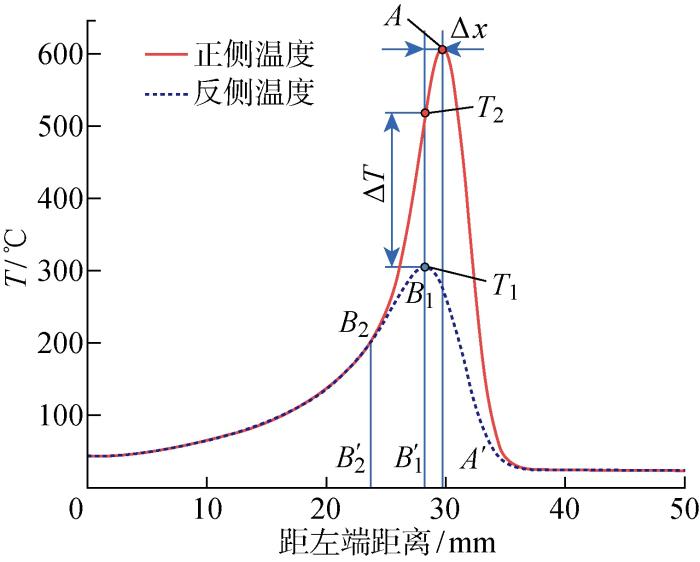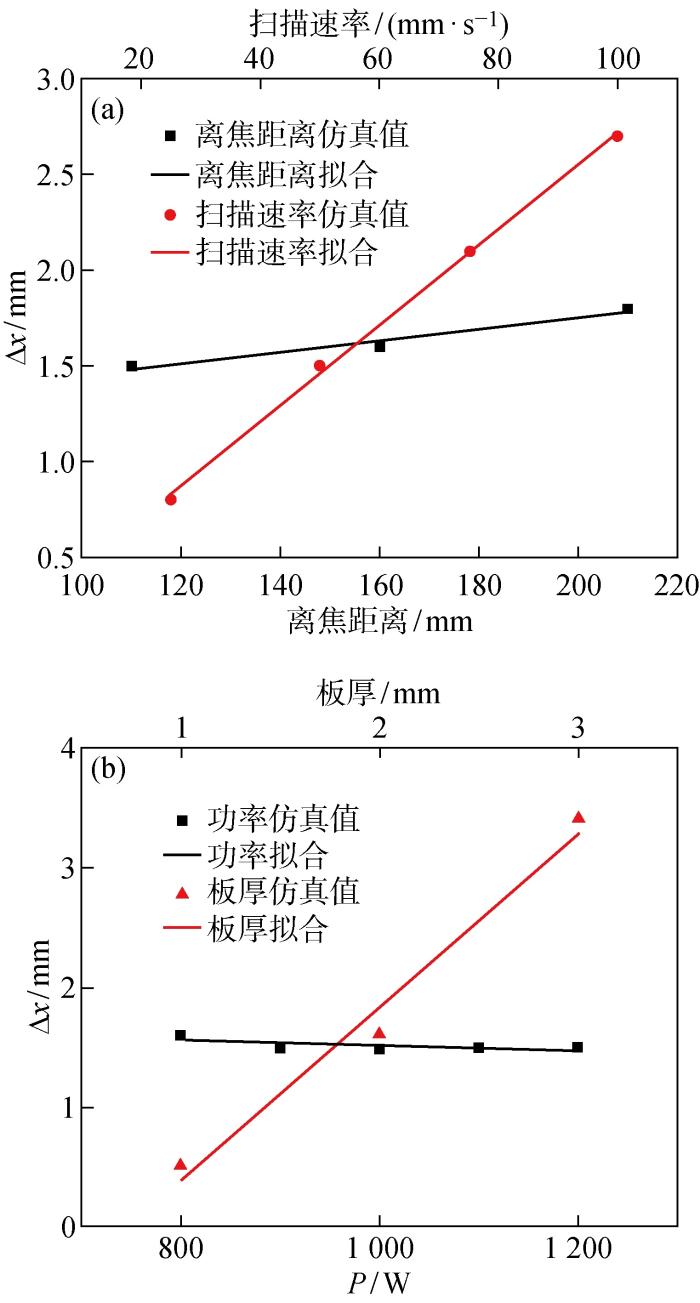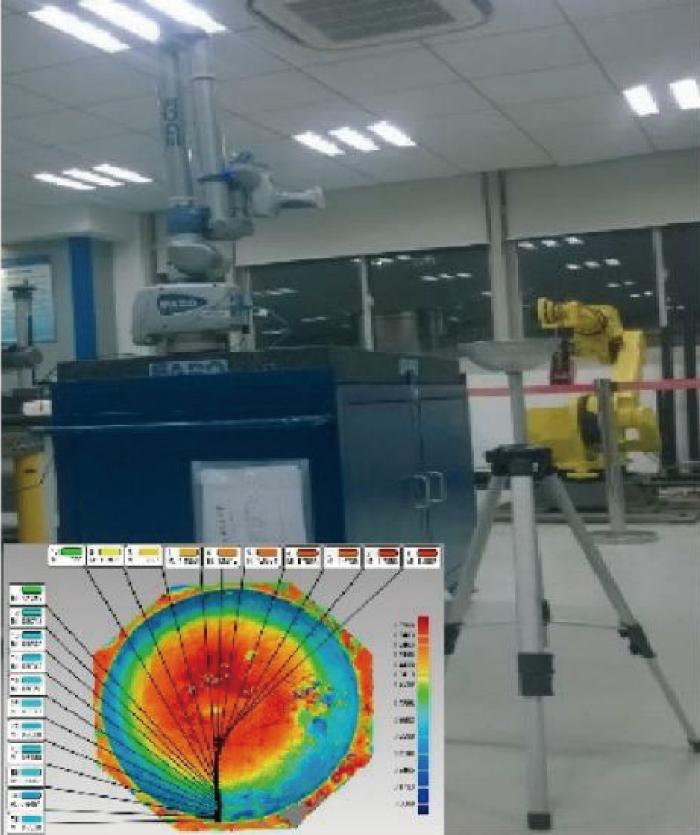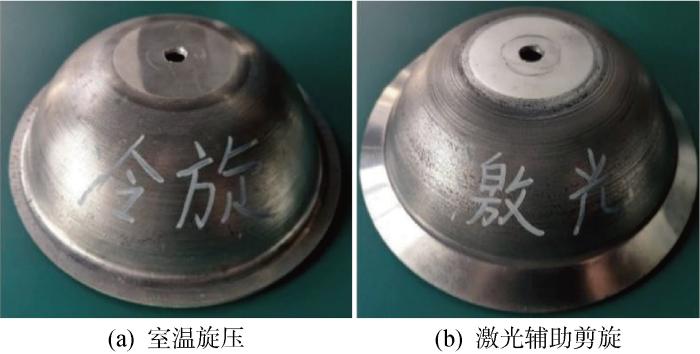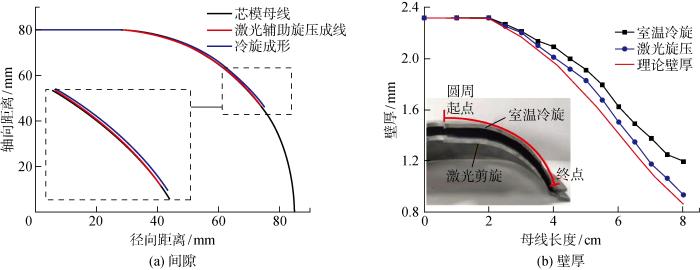金属旋压成形作为一种先进的局部塑性成形方法,由于具有高成形性能、低加工载荷、短制造周期等技术优势,逐渐成为航天飞行器薄壁构件高性能轻量化制造方法之一[1⇓-3].旋压成形中,由于材料塑性差、流动不均匀引发的断裂和起皱是主要的缺陷形式[4-5].对于难变形材料或高精度薄壁构件,为避免成形时产生缺陷,会引入辅助能场来提高材料塑性,如电辅助成形[6]、超声辅助成形[7]以及热辅助成形等.使用热辅助方式提高材料塑性的方式较为普遍,常用加热方式包括火焰加热、炉内加热、感应加热、温室加热和激光加热等[8].对于激光加热方式,激光热源可实现局部高温加热,具有热源集中和能量可控的优势[9].将激光热源引入强力旋压成形中,能实现局部加热与局部变形的合理匹配,是难成形薄壁构件的一种先进成形方法.
激光温度场作为局部加热能场,与旋轮载荷场的匹配是关键问题之一.针对旋压过程中激光照射点漂移问题,Klocke等[16]在激光器上增加了两个旋转自由度来实现复杂形状构件旋压过程中照射点位置的精准控制,但这套加热运动支架装置结构复杂,且需要专门工艺软件来协同控制激光支架运动与旋轮运动,对通用数控旋压机软硬件改造费时费力.激光作为强局部热源,适合引入强力旋压成形中,然而,目前还缺少激光照射点偏移的数学关系模型.该模型不仅要提供激光热源与通用旋压机在刚性连接条件下的热输入偏差计算依据,也要为精准热输入条件下激光器加热支架进给运动算法开发提供理论基础.此外,激光热源属于面热源,板坯加热需要利用热传导实现厚向板坯加热,为此,激光照射点要前置于旋轮作用点,如何确定二者的空间几何关系值得讨论.
在通用旋压机上,本文通过刚性连接激光热源建立热剪切旋压装置,分析激光照射点漂移对热输入的影响,研究在激光热源作用下的温度场特征,建立合理的加热点与旋压作用点之间的几何关系.在此基础上,以椭球面构件为例开展铝合金薄板室温和激光辅助剪切旋压试验,证明激光作为辅助热源在提升铝合金薄板可旋性和成形精度方面具备技术优势,为工程应用提供技术支持.
1 激光辅助旋压试验设计
1.1 激光辅助旋压试验平台搭建
在ZENN-100数控旋压机上搭建激光辅助旋压平台,如图1所示.激光热源为YLR-1500单模谐振激光发射器,通过支架将激光发射器固定在旋压机的旋转刀架上,与旋压机床刚性连接,使激光加热器与旋轮刀架空间位置相对固定.激光照射点始终位于旋轮作用点前侧待变形区,且在周向上前置一段距离以实现对变形区的随动加热.
图1
图1
激光辅助旋压试验平台
1—芯模;2—旋轮;3—尾顶组件;4—激光器组件;5—支架;A—激光照射点;B—旋轮作用点
Fig.1
Test platform of laser assisted spinning
图2
1.2 激光照射点漂移模型
在实验设备关联机构为刚性连接条件下,随着旋轮进给,激光照射点会出现一定的偏差.偏差是由剪旋过程中芯模半径变化引起的照射点位置偏移和剪切旋压螺旋线加工轨迹所引起,这两方面因素都会使激光热源加载点的位置出现径向和轴向偏差.
(1) 芯模半径变化引起的照射点径向位置偏移.
由于激光加热器与旋轮刀架空间位置相对固定,即在XOY平面上,激光点-旋轮点间距L及其夹角β保持不变,如图3所示.随着旋轮进给,旋压作用点B所处位置的芯模半径Rw逐渐增大,后续激光照射点A'和旋轮作用点B'在径向上会出现逐渐变大的偏差Δr1.令激光照射点A'处的芯模半径为RL,结合旋轮作用点B'处的芯模半径Rw,根据几何关系计算径向偏差距离Δr1.
图3
图3
激光照射点与旋轮作用点之间位置偏差
Fig.3
Position deviation between laser irradiation point and spinning point
由图3(a)可知,起旋位置芯模半径为R0,则夹角为
旋轮移动到点B',激光照射点A'处的芯模半径为
激光照射点A'和旋轮作用点B'在径向上存在偏差距离为
(2) 螺旋线轨迹引起的照射点径向位置偏移.
旋压属于连续加载局部成形,旋轮工艺轨迹在XOY平面上的投影为阿基米德螺旋线如图4所示,取OX轴为极轴,在极坐标系下其轨迹公式表示为
式中: ρ为极径;Vr为径向进给比;θ为极角.极轴为通过芯模轴心的水平线.
图4
因此,激光照射点A与旋轮作用点B存在径向上偏差为
式中:θA和θB分别为点A和B点的极角;ρA和ρB分别为点A和B点的极径.
由图4可知,剪旋过程中极径ρ值不断增大.在维持弧长
式中:Δθ0为在初始状态下AB两点间的极角差值.
在初始条件下,根据余弦定理有
综上所述,由刚性连接引起的总径向偏差为
根据经验,剪切旋压沿母线方向进给比范围一般为0.10~0.75 mm/r,该范围内沿径向分量Vr会更小,且Δθ较小,计算存在超越方程难以求得精确解析解的问题.根据式(6)和(7)可估算得知,径向偏差变化范围为0.009 mm≤Δr2,max≤0.094 mm.相比于Δr1属于高阶小量,因此可将刚性连接引起的径向偏差近似认为
(3) 芯模半径变化引起的照射点轴向偏差位置偏移.
如图3(b)所示,在XOZ平面上,起旋时激光照射点A与旋轮作用点B在轴向上重合,随着旋轮进给,激光照射点A与旋轮作用点B会处于不同的芯模半径位置,导致其轴向位置产生偏差ΔZ.
轴向偏差距离ΔZ与芯模的外轮廓曲线方程相关,使用椭球面模具的外轮廓曲线方程为
由图3(b)可求得后续激光照射点A'的坐标为(RL,Lsin β,
由式(11)可知,ΔZ由Δr计算得到.如前文所述,螺旋线轨迹引起的照射点径向位置偏移可忽略不计,因此其带来的轴向偏差在本文中也忽略不计.
为了直观描述式(9)中径向偏差和式(11)中轴向偏差随参数Rw和L的变化趋势,使用MATLAB绘制变化曲面图,如图5所示.可知,随着旋轮进给,径向偏差和轴向偏差均逐渐增大;起旋时激光点-旋轮点间距越小,径向偏差与轴向偏差也越小.
图5
2 激光辅助旋压工艺设计
激光辅助旋压中,提升成形性的关键是实现局部温度场与局部载荷场的匹配程度.通过分析激光热源作用下的铝合金板材温度场特征,提出激光照射点位置设计策略.
2.1 激光加热温度场仿真
在激光辅助旋压仿真模型中,激光能场的输入通常采用高斯面热源,公式如下:
式中:q(x, y)为在点(x, y)处的热流密度;P为激光发射功率;ra为激光在照射面形成的光斑半径;α'为材料的光学吸收系数.
图6
表1 铝合金2024材料热物性参数
Tab.1
| 温度/℃ | 比热/(J·g-1·K-1) | 导热系数/(W·mm-1·K-1) |
|---|---|---|
| 300 | 1.01 | 175 |
| 350 | 1.03 | 178 |
| 400 | 1.06 | 182 |
| 450 | 1.09 | 185 |
| 500 | 1.12 | 188 |
| 550 | 1.15 | 192 |
| 600 | 1.18 | 195 |
利用激光加热温度测量试验[18]验证仿真模型的准确性.试验中,对铝合金板双面进行黑漆喷涂以提高激光吸收率,同时使用红外摄像仪拍摄铝合金反面实时温度,得到某一时刻铝合金板反面的温度场分布,并与仿真模型计算值进行对比验证.
图7为不同激光功率和扫描速率条件下反面温度(T)仿真结果与试验对比.可以发现,仿真结果与试验吻合很好,表明利用有限元模型反求激光加热温度场可信.
图7
图7
反面温度有限元仿真与试验对比
Fig.7
Comparison of finite element simulation results with experimental results of opposite side
图8
根据图8温度分布特征,考虑到板材反面温度尽量高且正反面温差尽可能小,旋轮作用点位于B1至B2之间更合适,其中B2为正反两面温度相等处,即激光照射点应领先于旋轮作用点前侧直线距离[A'B'1, A'B'2].
数值仿真表明:激光功率对Δx影响较小,而随扫描速率、离焦距离以及坯料厚度影响较大(见图9).显然,随着离焦距离和扫描速率的减小,Δx也被缩短,这是由于离焦距离对热流密度产生影响,而扫描速率则影响了铝板单位面积接受的能量,而厚度则影响了坯料的热传导时间,因而滞后程度增加.
图9
图9
激光加热参数对铝合金正反面最高温度点间距影响
Fig.9
Influence of laser heating parameters on spacing between maximum temperature on both sides of aluminum blank
2.2 激光照射位置设计
图10
3 铝合金板材激光辅助旋压试验
在剪切旋压中,主轴转动分为恒角速度匹配和恒线速度匹配两种.恒角速度是旋压全过程中芯模转速保持恒定,不随旋压变形区对应的芯模周向半径改变;恒线速度是旋压全过程中芯模转速变化,随旋压变形区对应的芯模周向半径的增大而逐渐减小,使旋轮在周向的线速度保持恒定.对于激光辅助旋压,工件温度受激光扫描速率影响,因此恒线速度更为适合.采用恒线速度,只需保证激光照射点与旋轮作用点之间的弧长
3.1 旋压试验设计与成形件质量评价方法
表2 激光辅助剪旋实验参数
Tab.2
| 材料 | 初始 板厚/mm | 旋轮圆角 半径/mm | 进给比/ (mm·r-1) | P/W | 离焦 距离/cm | 恒线速度/ (mm·s-1) | Δx/mm |
|---|---|---|---|---|---|---|---|
| 7075-T6 | 1.85 | 5 | 0.5 | 1200 | 11 | 100 | 2.2 |
| 2024-O | 2.32 | 5 | 0.5 | 400 | 11 | 200 | 3.4 |
图11
图12
3.2 板料可旋性提升
图13
3.3 尺寸精度提升
图14
图15
图15
2024-O铝合金试验件尺寸测量
Fig.15
Size measurement of 2024-O aluminum alloy spun workpieces
图15(b)的厚度分布曲线对比表明:激光辅助旋压件厚度稍大于正弦规律中的剪切理论厚度,且偏离值几乎恒定,这主要是由旋压机刀杆退让造成的;而室温旋压件厚度产生了更大偏差,且随着剪切半锥角变小,偏差值变大,这说明随着厚度减薄增加以及加工硬化的出现,径向旋压力增加带来了更大的设备退让,导致厚度偏差加大.
综上所述,激光辅助旋压成形可提升旋压成形件的贴模度,且壁厚更接近理论值,这表明激光辅助旋压可有效提升铝合金旋压尺寸精度.同时,证实在本文所使用的模具和设备条件下,激光辅助剪切旋压工艺设计方法可行.
4 结论
搭建激光辅助剪切旋压实验平台,建立成形过程中激光照射点漂移模型,提出激光照射位置设计方法,开展铝合金薄板室温和激光辅助剪切旋压试验,获得如下结论:
(1) 在截面半径变化不大于60 mm的构件截面变动条件下,激光加热温度波动在5%以内,波动不明显,可以满足激光辅助旋压试验的近似均匀热输入的要求.
(2) 定义出剪切旋压过程中激光在板坯法兰上照射点的空间位置,激光照射点应在旋轮拉弯区靠近法兰一侧.
(3) 激光辅助旋压可显著提高难成形薄板可旋性,7075-T6态铝合金减薄率可增加30%,同时明显改善薄壁旋压件贴模度和厚度均匀性.
参考文献
铝合金大型薄壁异型曲面封头旋压成形研究进展
[J].
DOI:10.3901/JME.2018.09.086
[本文引用: 1]

大型薄壁异型曲面整体构件是航天航空等重要领域迫切需要的高性能轻量化构件。旋压和淬火是实现该类构件整体化制造和性能控制的一种有效途径。然而,大型薄壁异型曲面旋压是多因素耦合作用下的多道次局部加载/卸载复杂过程,成形过程中易出现局部损伤破裂、起皱、隆起、不贴模等缺陷,且旋压后的淬火过程还易造成大的残余应力和淬火变形,并决定着构件的最终使用性能。在建立大型薄壁异型曲面构件旋压和淬火全过程有限元模型的基础上,分析大型薄壁异型曲面构件旋压过程中应力应变分布与变化规律;研究失稳起皱缺陷的形成机理,获得旋压工艺参数对薄壁壳体凸缘周向压应力的影响规律,提出控制凸缘起皱的方法;研究板坯尺寸波动对成形质量的影响;研究获得大型薄壁异型曲面封头旋压件淬火残余应力分布规律和淬火变形规律。
Advances in spinning of aluminum alloy large-sized thin-walled and special-curved surface head
[J].
DOI:10.3901/JME.2018.09.086
[本文引用: 1]

Large-sized thin-walled and special-curved surface heads are the urgent needs of aerospace and aviation industry for its high-performance and lightweight. Spinning-quenching is one effective integral forming process to manufacture these components. However, the spinning of large-sized thin-walled and special-curved surface head is one of the complicated local loading/unloading processes under the action of multi-parameters and their coupled effects. In this process, the heads are very prone to produce forming defects, such as local damage rupture, flange wrinkling, local bulge, and unfitting. Additionally, the quenching treatment after spinning will lead to heavy quenching distortion and residual stress, thus seriously deteriorate the material performance. In this work, a finite element model for the whole process of spinning-quenching are established. Based on the model, the distribution and evolution of stress and strain field of the large-sized thin-walled and special-curved surface heads during spinning process is analyzed. In order to obtain the effect laws of process parameters on flange circumferential compressive stress, the mechanism of flange wrinkling is investigated, and a method of controlling the flange wrinkling is proposed. The effect laws of the thickness variation of slabs on deformation quality are investigated. The quenching residual stress and distortion of the large sized thin-walled and special-curved surface heads are also studied.
交叉内筋薄壁筒体错距旋压成形数值仿真
[J].
Numerical simulation of stagger spinning of cylindrical part with cross inner ribs
[J].
A review of process advancement of novel metal spinning
[J].DOI:10.1016/j.ijmachtools.2014.05.005 URL [本文引用: 1]
An extended GTN model for low stress triaxiality and application in spinning forming
[J].DOI:10.1016/j.jmatprotec.2018.07.032 URL [本文引用: 1]
多道次普旋预成形阶段法兰起皱预测
[J].
Study on flange wrinkling prediction in preforming stage during multi-pass conventional spinning
[J].
2060-T8铝锂合金槽形件的电辅助增量成形
[J].
Electrically-assisted incremental sheet forming process for 2060-T8 Al-Li alloy
[J].
铝合金带筋构件超声辅助旋压仿真研究
[J].
Simulation study of aluminum alloy ribbed member spinning with ultrasonic vibration
[J].
Review on hot spinning for difficult-to-deform lightweight metals
[J].DOI:10.1016/S1003-6326(15)63778-5 URL [本文引用: 1]
Laser-assisted metal spinning for an efficient and flexible processing of challenging materials
[J].DOI:10.1088/1757-899X/119/1/012022 URL [本文引用: 1]
The effect of local heating by laser irradiation for aluminum, deep drawing steel and copper sheets in incremental sheet forming
[J].DOI:10.1016/j.phpro.2015.11.045 URL [本文引用: 1]
Laser assisted incremental forming: Formability and accuracy improvement
[J].DOI:10.1016/j.cirp.2007.05.063 URL [本文引用: 1]
Laser-assisted metal spinning of challenging materials
[J].DOI:10.1016/j.proeng.2014.10.338 URL [本文引用: 1]
金属剪切旋压成形时的韧性断裂准则
[J].
DOI:10.3901/JME.2018.14.066
[本文引用: 1]

破裂是剪切旋压时最主要的失效形式。为实现对剪切旋压时破裂的精确预测,根据剪切旋压成形时变形区材料的受力特点,提出对基于材料压缩变形塑性本构模型的Oyane准则进行研究。以DP600高强钢为研究对象,通过ABAQUS软件的VUSDFLD子程序二次开发,将Oyane准则耦合到剪切旋压有限元模型进行断裂损伤的计算及断裂阈值的判断。通过椭球形芯模旋压试验对断裂预测结果进行验证。结果表明,基于Oyane准则模拟得到的断裂危险位置位于已变形区靠近变形区处并沿着切向均匀分布,与试验结果的分布规律一致;但基于模拟所得到的极限减薄率与试验结果之间的相对误差达到33.8%。在Oyane准则的基础上,通过考虑平均应力和最大剪切应力对韧性损伤过程的影响,构建出适用于剪切旋压成形的修正韧性断裂准则。结果表明,采用修正后的韧性断裂准则,模拟得到的极限减薄率与试验结果的相对误差仅为15.9%;与Oyane韧性断裂准则相比,相对误差减小了17.9%。获得适用于剪切旋压时的韧性断裂准则,为金属剪切旋压成形破裂的精确预测奠定理论基础。
Ductile fracture criterion for metal shear spinning
[J].
DOI:10.3901/JME.2018.14.066
[本文引用: 1]

Fracture is the main failure mode during shear spinning. The investigation of Oyane criterion based on constitutive mode of compression plastic deformation is proposed according to the stress state of the deformation zone during shear spinning to realize the accurate prediction of fracture. The Oyane ductile criterion is coupled to the finite element model of shear spinning of DP600 high strength steel based on the secondary development through the subroutine VUSDFLD of software, ABAQUS. The damage integral calculation of Oyane ductile criterion and the judgment of fracture threshold during shear spinning are carried out. The spinning experiment with ellipsoid mandrel is carried out to verify the simulation results of fracture prediction. The results show that the fracture position during shear spinning predicted by Oyane criterion is located in the deformed zone near the deformation zone and distributed uniformly along the tangential direction, which is in good agreement with the experimental result. However, the relative error of the maximum thinning ratio between the simulation and experiment reaches to 33.8%. Therefore, a modified ductile fracture criterion based on the Oyane criterion for fracture prediction during shear spinning is proposed by considering the influence of mean stress and maximum shear stress on the ductile damage process. The results show that the relative error of maximum thinning ratio predicted by the modified criterion is only 15.9%, which is decreased by 17.9% compared with the Oyane ductile fracture criterion. The ductile fracture criterion applied to metal shear spinning is obtained, which can provide the theoretical basis for the accurate prediction of fracture during metal shear spinning.











